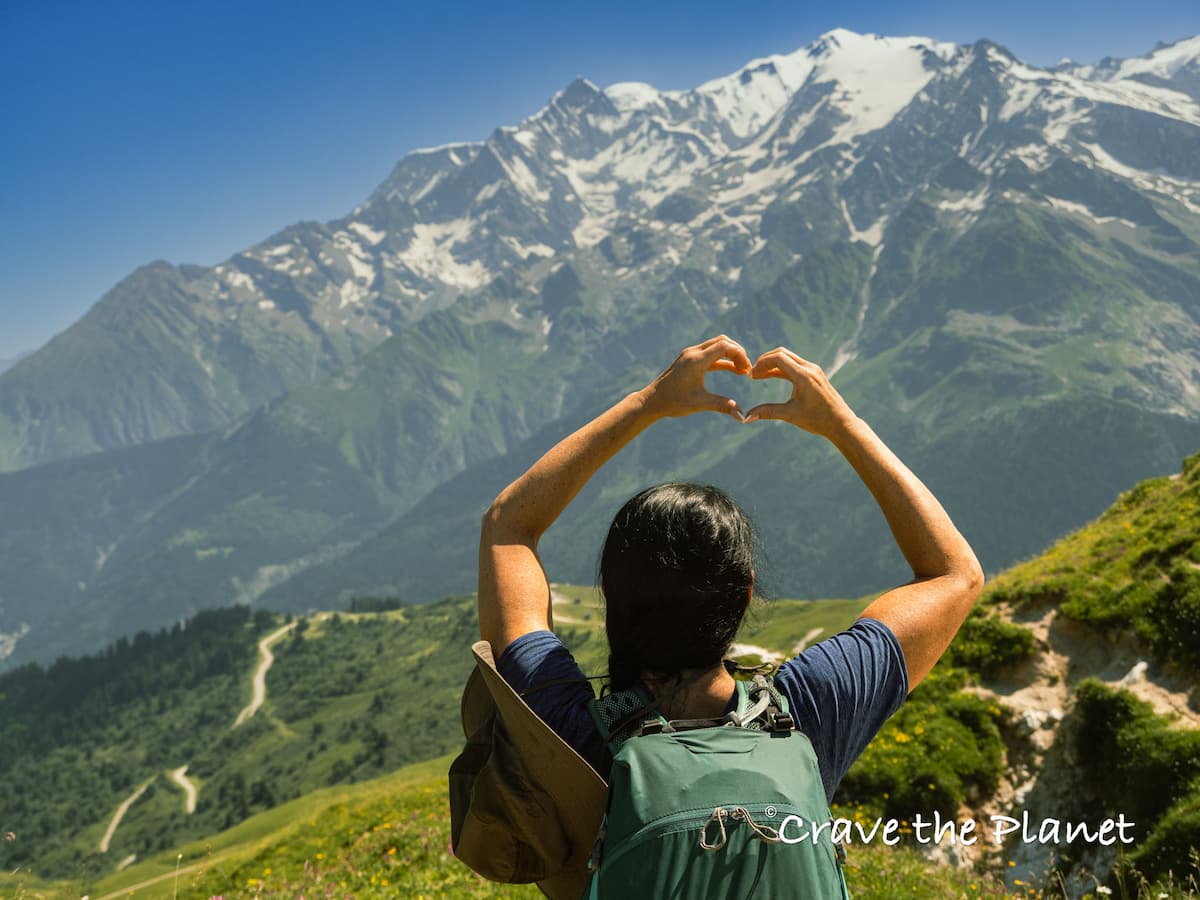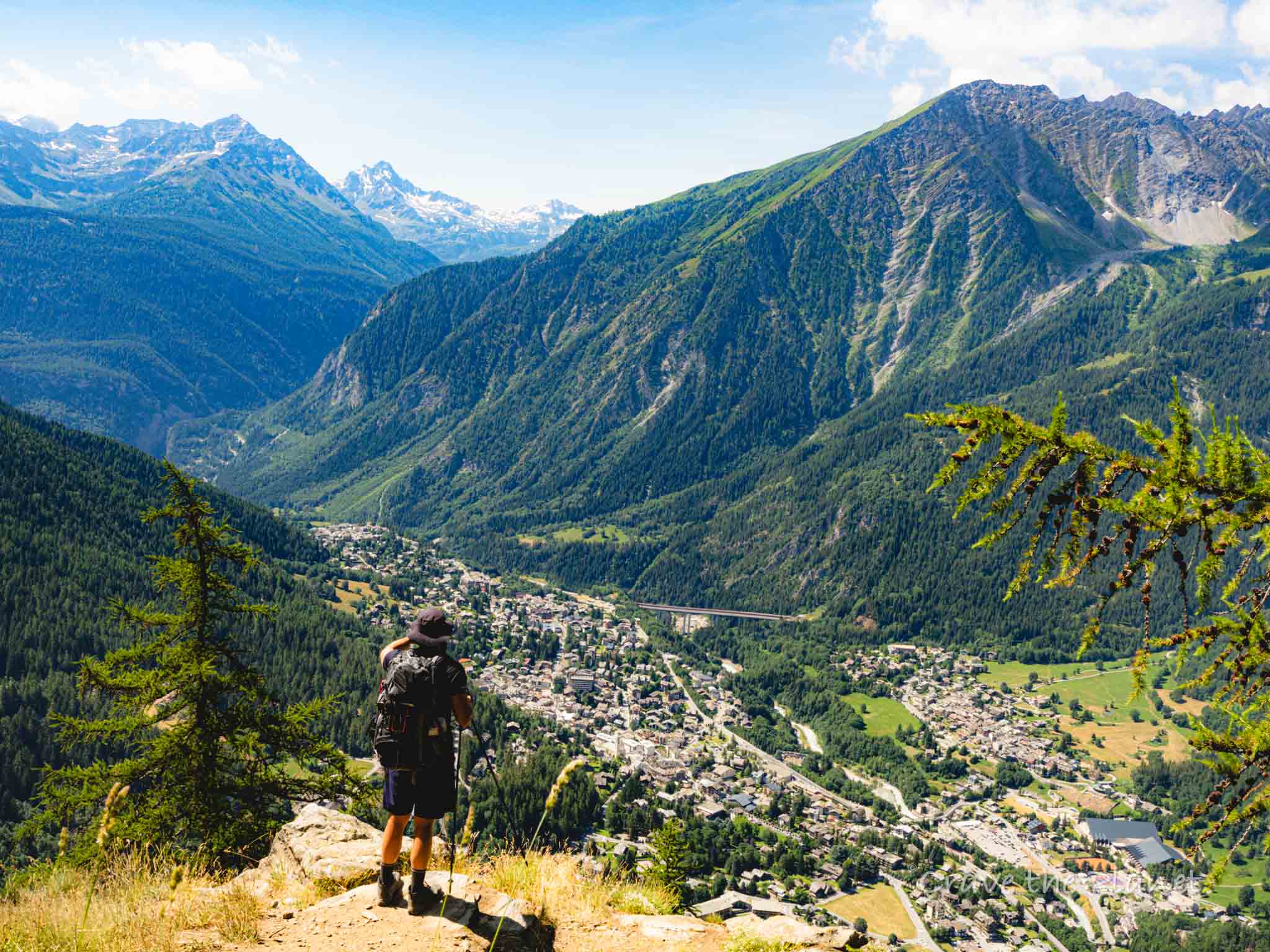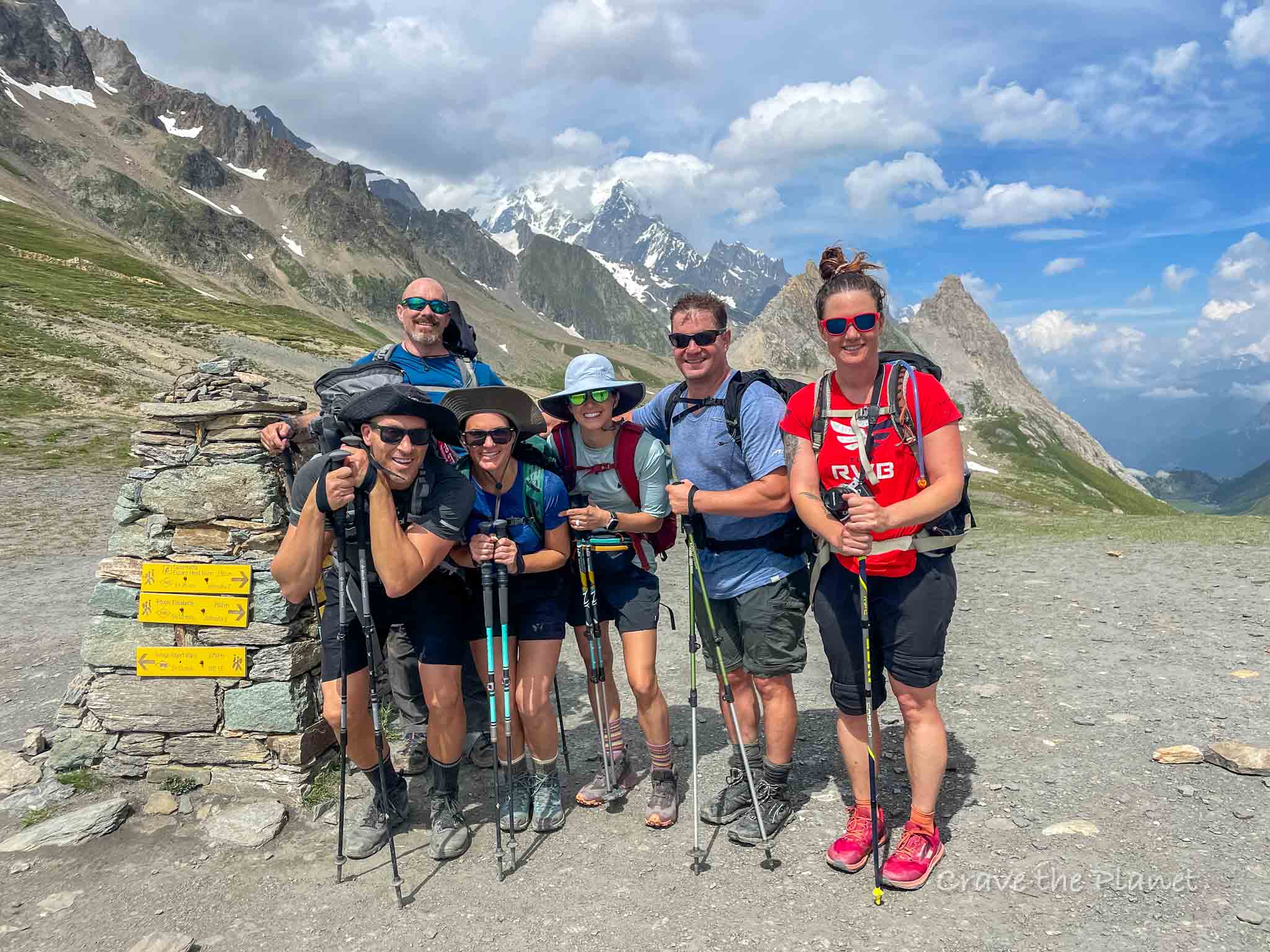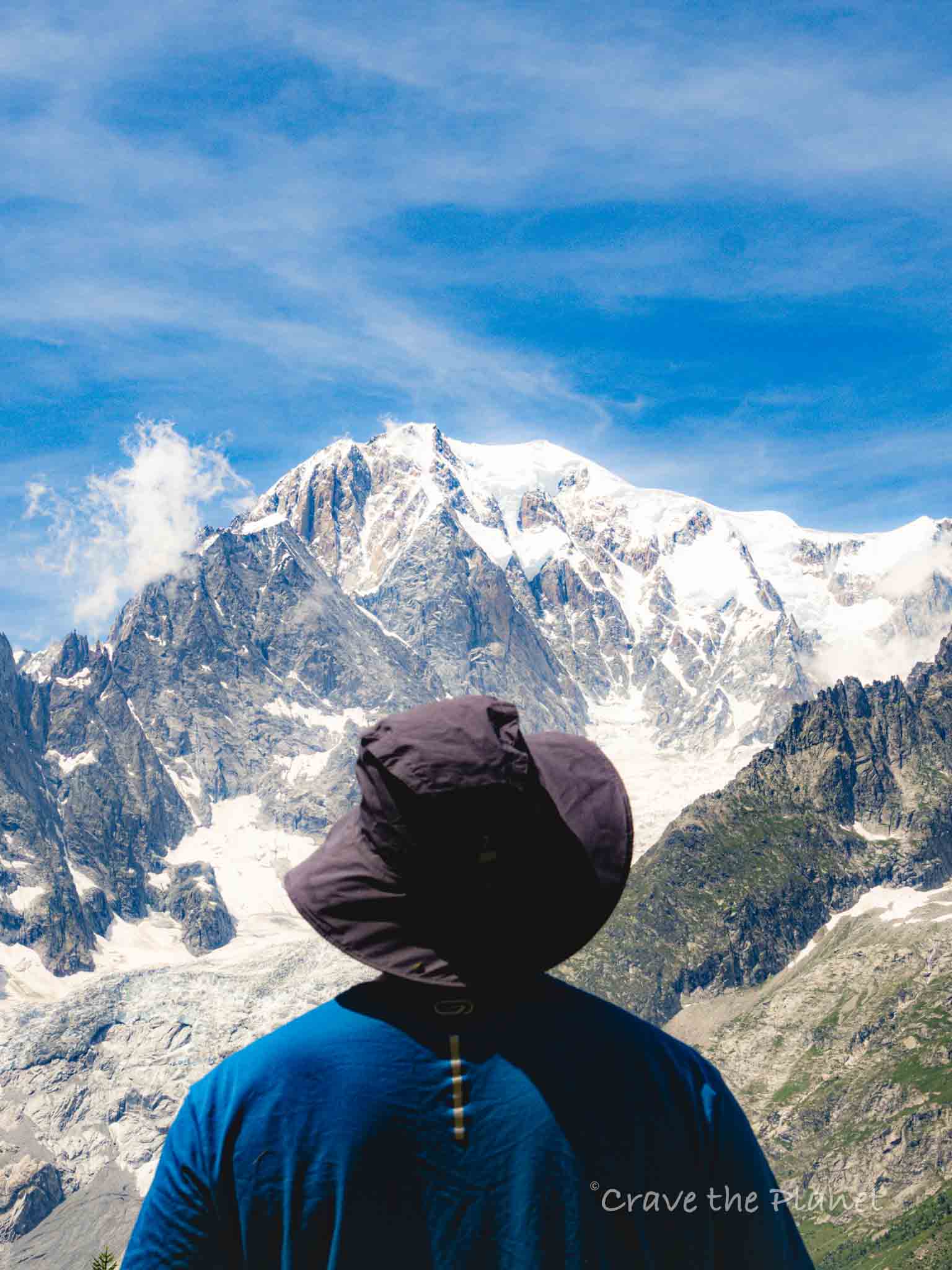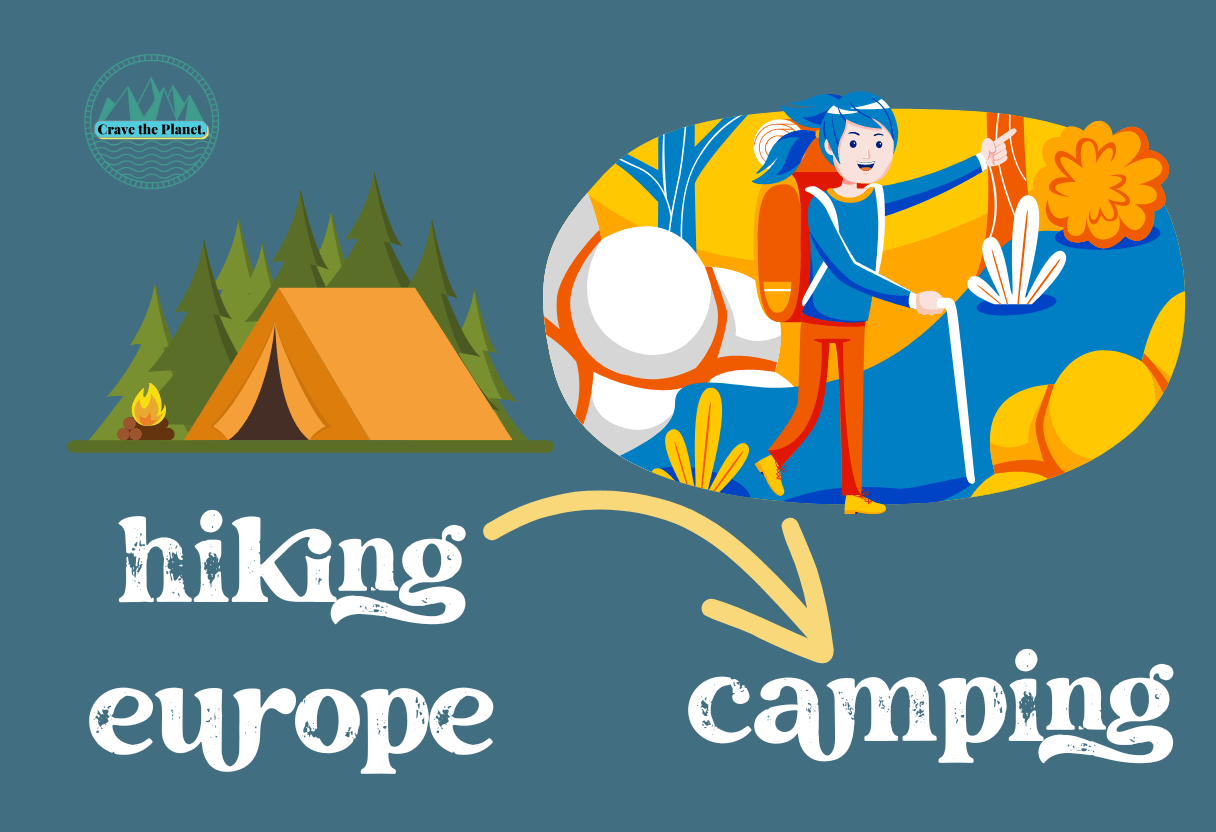Staying in mountain huts in Europe, also known as refuges or rifugios, offers a unique way to experience the natural beauty of the European Alps on a more eco-friendly style of travel.
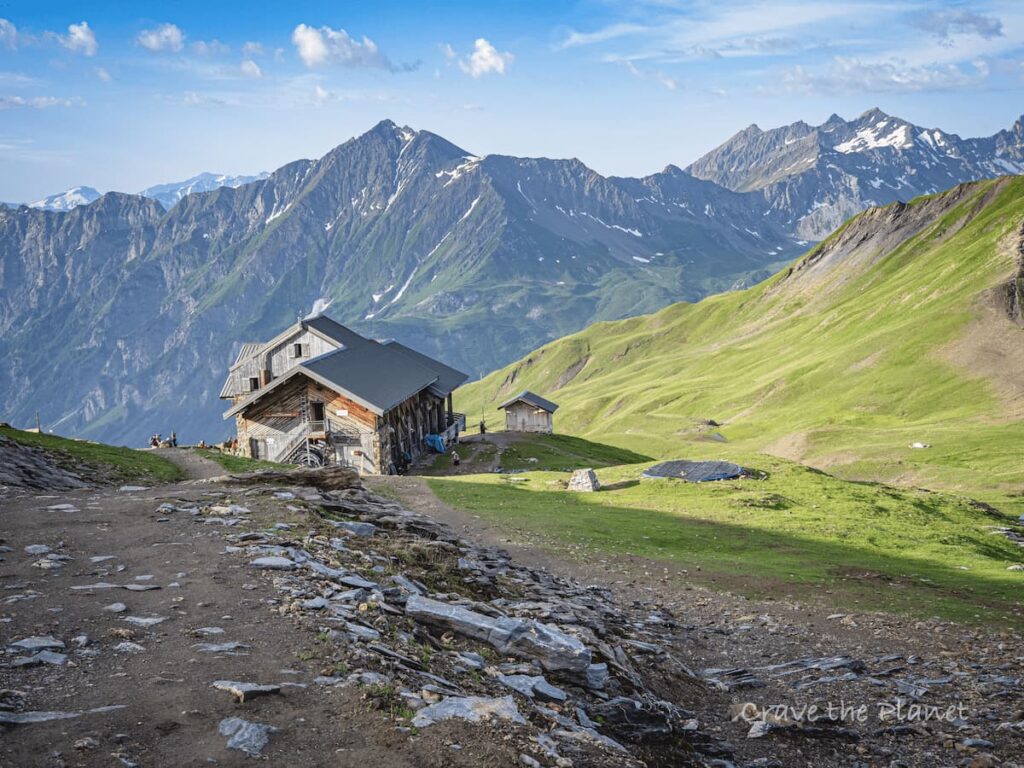
These huts provide a place to rest and shelter for hikers, climbers, and nature enthusiasts traversing the diverse terrains from Slovenia to France.
Often run by local alpine clubs or private owners, these huts are strategically located to offer spectacular views, a taste of local culture, and a communal atmosphere where stories and tips are exchanged freely.
When planning a hut-to-hut trip across the mountains of Europe, it’s essential to prepare adequately. The 2 most popular hut to hut routes in Europes are the Alta Via 1 and the Tour du Mont Blanc hike.
In fact:
You’ll want to understand the booking process, hut etiquette, and what amenities to expect, as these can vary from basic dormitory-style accommodations to more comfortable settings with meals and hot showers.
It is crucial to pack light but bring essential gear and clothing suited for rapid weather changes in mountainous environments.
Short on time?
Ready to book an adventure? These are my personal recommendations based on experience.
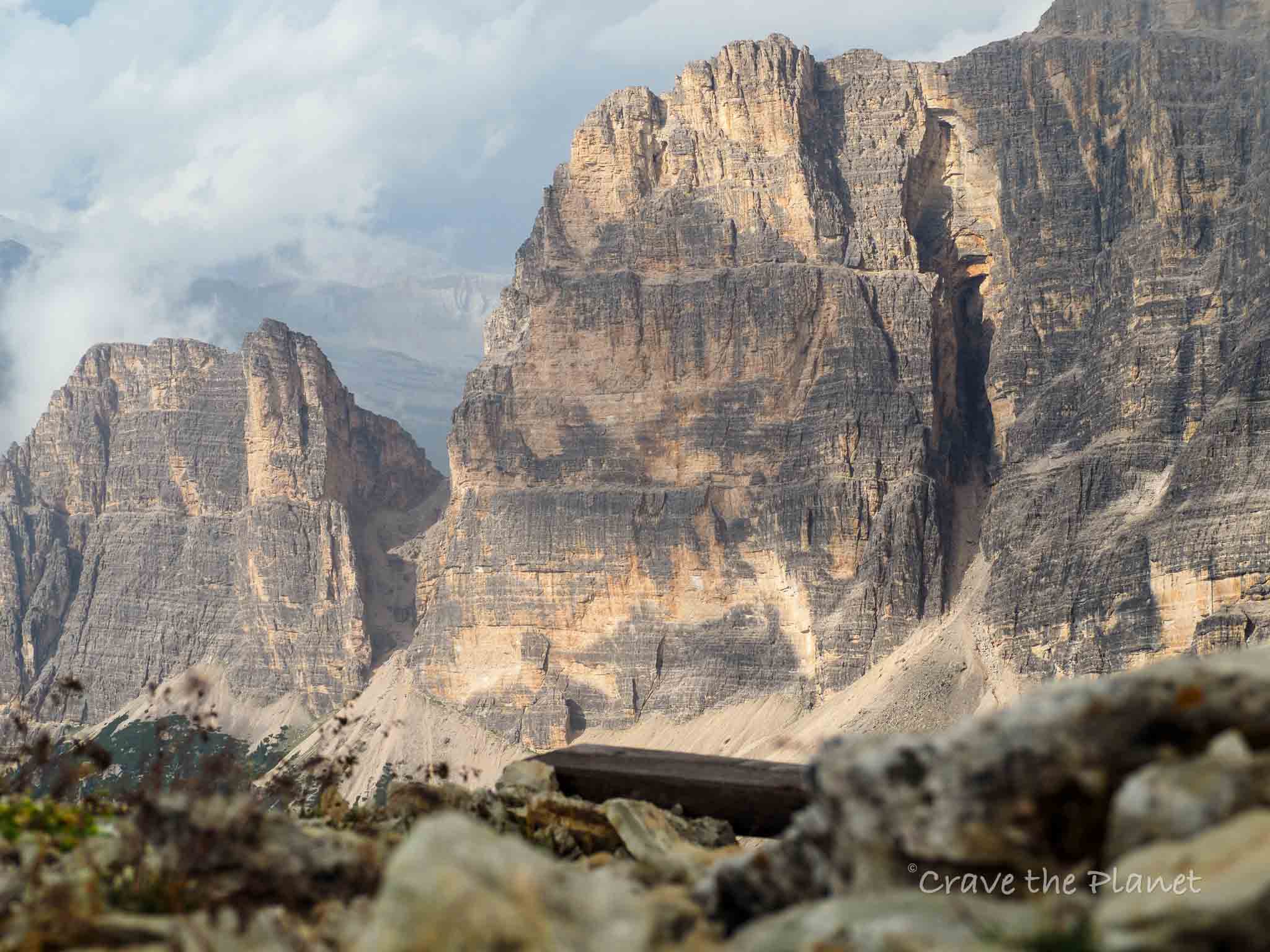
- Italian rifugios make excellent cuisine
- Dolomites scenery is out of this world
- 4-15 day options
What we liked: Food and wine, moonscapes, opportunity to tie with Venice/Bolzano city break.
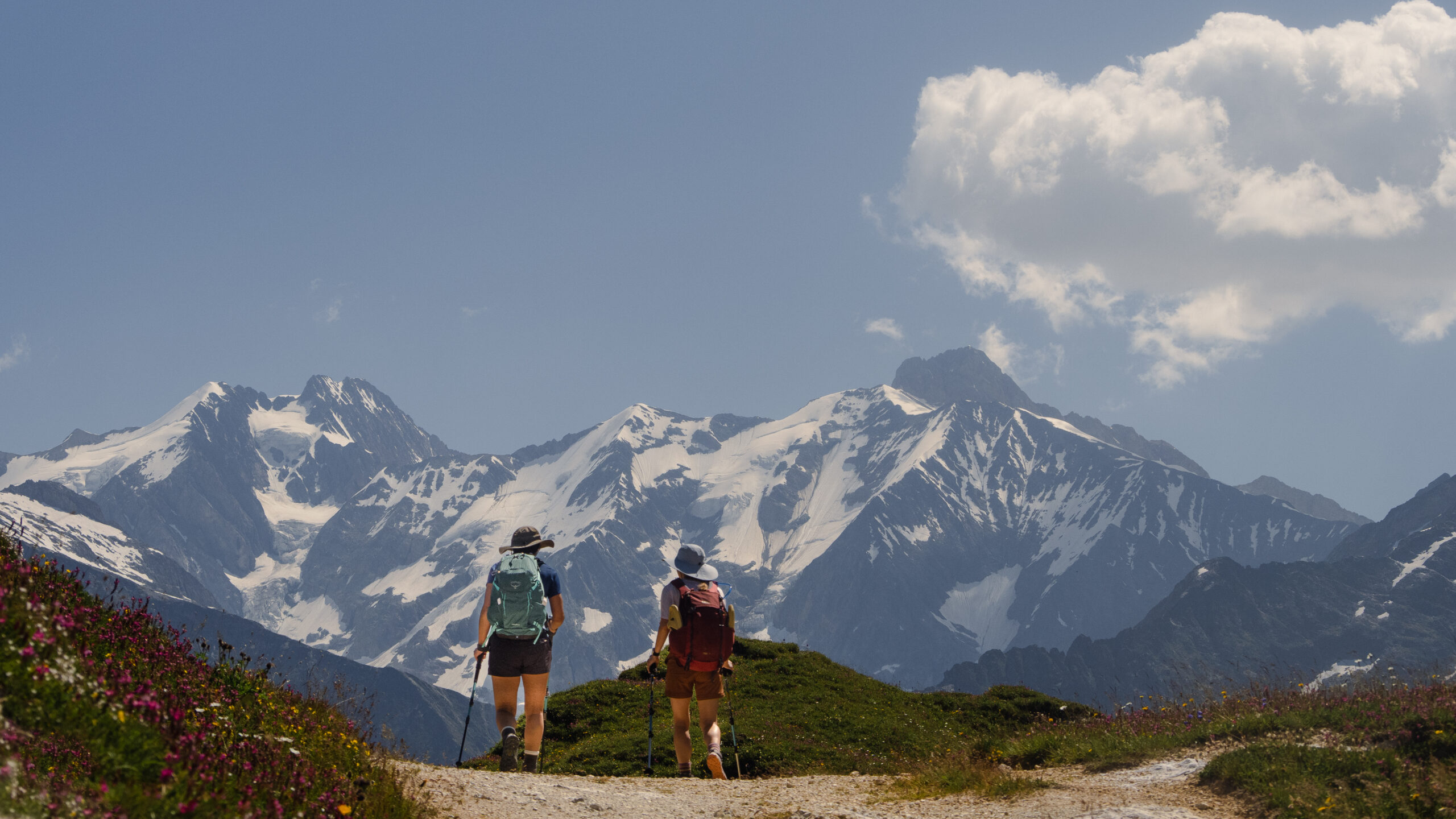
- Far more rugged than TMB
- For more advanced hikers
- 4-13 day options
What we liked: More solitude, mountain lakes, easier to book last minute.
What You Will Learn
- Become a European Adventure Travel Insider in Just 5 minutes
- What is it Like Staying in Mountain Huts in Europe?
- Preparing for Your Hut Stay
- Exploring Hut Systems by Country
- Day-to-Day Hut Life: Food, Amentities
- Cultural Experience and Etiquette
- Trekking and Hiking Trails
- Extended Trips and Advanced Planning
- What Kind of Hiker Are You Quiz
- Membership and Affiliations
- Safety and Emergency Information
- Sustainability and Environmental Responsibility
- Seasonal Considerations
- Final Thoughts
- Ready to Book a Hut to Hut Hike?
- Final Verdict: Ways to Book a Hut to Hut Hiking Trip
- Frequently Asked Questions
Become a European Adventure Travel Insider in Just 5 minutes
✨Unlock Europe’s best-kept secrets with our free bi-weekly newsletter.
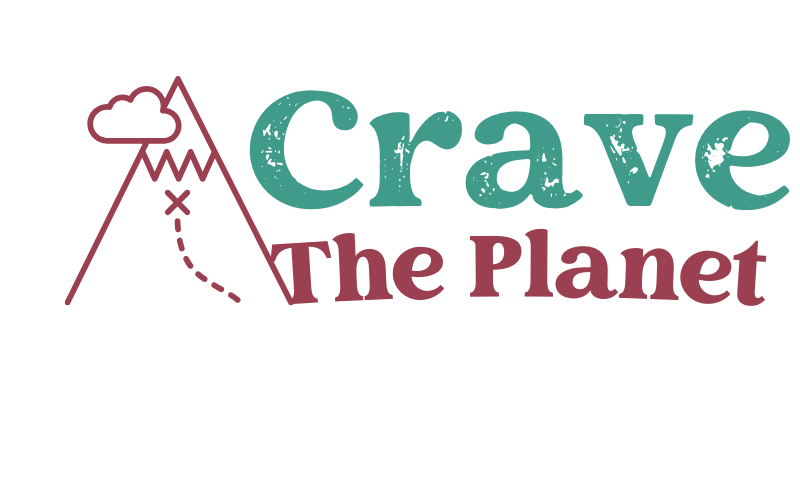
What is it Like Staying in Mountain Huts in Europe?
Morgan’s Video of the Hut food scene in Dolomites
European mountain huts provide a unique and essential service for hikers and climbers. These shelters not only offer a place to rest and replenish but also embody a rich history linked to the development of mountaineering in the Alps.
Familiarizing yourself with the different hut systems by country will also help in planning your route effectively, ensuring a memorable journey.
Definition by Language
European mountain huts, known as rifugi in Italian, refuge in French, and Hütte in German, are facilities that offer accommodation and food to mountaineers and hikers traversing the diverse ranges of Europe, including the well-known Alps.
History
Their origin dates back to the 19th century, when the growth of alpinism necessitated secure bases where adventurers could take refuge from the harsh mountain environment.
- 1833: The creation of the first recorded mountain hut, the Grands Mulets Hut on Mont Blanc.
- Late 1800s: Significant expansion in the number of huts as organized mountaineering clubs formed.
Types of Huts
Mountain huts in the Alps vary in comfort and services offered, from basic shelters without custodians to staffed facilities offering hot meals and sleeping arrangements.
- Basic shelters: Also called bivouac huts, these are often unstaffed and provide minimal amenities.
- Staffed huts: These larger huts come with a host and provide amenities like beds, meals, and sometimes even hot showers. They can be further categorized based on the level of comfort they provide.
Whether you’re seeking a simple haven from the elements or a comfortable place to rest and socialize, these mountain refuges are an integral aspect of your Alpine adventure.
Preparing for Your Hut Stay
Staying in mountain huts offers a unique experience combining the comfort of shelter with the beauty of the European highlands. Ensuring you have a smooth adventure requires proper planning and preparation. Here’s how to get ready for your stay:
1. Booking Procedures
Make your reservation well in advance, especially during peak hiking seasons. For many huts, you can book online directly through the hut’s website or through regional alpine associations.
Ensure that you receive a confirmation and understand the cancellation policy, as mountain hut availability can be limited and is often in high demand.
2. Packing Essentials
Your packing list should include only what’s necessary, as you’ll be carrying it all in your backpack. Essentials include:
- Clothes: Layered, breathable clothing that can handle a wide range of temperatures.
- Hiking boots: Durable and waterproof for the challenging terrain.
- Sleeping bag liner: Most huts provide bedding, but a liner adds a layer of warmth and hygiene.
- Gear: Headlamp, multi-tool, and a first-aid kit.
- Bedding: Check if the hut provides it; if not, pack a lightweight sleeping bag.
Related
👉 Hut to Hut Packing List Tips
Hut to Hut Hiking Gear Essentials
- Sleeping Bag Liner: Each hut provides sheets, blankets, and pillows, but you need to bring a sleeping bag liner.
- Trekking Poles: The elevation gain is not a lot but it is steep and slippery in parts.
- Hut Shoes: You cannot wear your boots inside huts, so bring a pair of slides or flipflops
- Sunglasses: The days are long, bright and sunny (or blizzard in August).
- Trekking Backpack: The best hut hiking backpack is the Osprey Sirrus 24 liter. If you have a lot of camera gear you could size up to a 36 liter.
- Hiking Boots and Trail Shoes: Make sure you have traction and enough room in your toe box.
🔥 Check out my online buying guide if you are starting from scratch.
3. Weather Considerations
Always check the weather forecast before departing. Weather in the mountains can change swiftly, so prepare for various conditions.
Carry waterproof and wind-resistant clothing, as well as additional layers for warmth. Your safety and comfort depend on how well you anticipate weather changes.
Remember that a successful hut-to-hut trip hinges on your ability to plan, pack smartly, and adapt to the unpredictable mountain environment.
Exploring Hut Systems by Country
Europe offers a diverse and extensive network of mountain huts, each providing a unique way to experience the natural beauty of the continent’s various mountain ranges. This system allows you to immerse yourself in the landscape, providing comfort and camaraderie at the end of a day’s hike.
Italy’s Rifugi
In Italy, particularly in the majestic Dolomites, you can follow routes like the Alta Via 1 that connect a series of rifugi. These refuges offer a place to rest and refuel, with the dramatic backdrop of towering peaks around you.
The huts are accustomed to hikers journeying through and are well-equipped to offer a warm bed and hearty meals.
Best Italian Hut to Hut Self-Guided Hikes
Switzerland’s Mountain Huts
Switzerland has a storied history of mountaineering, and its mountain huts are an integral part of this tradition. When traversing high altitudes, these huts not only serve as essential waypoints for resting but also for safety and guidance in the face of Switzerland’s rugged terrain.
Best Swiss Hut to Hut Self-Guided Hikes
France and the Tour du Mont Blanc
Your journey through France might lead you to the famous Tour du Mont Blanc, where a network of huts facilitates a multi-day circumnavigation of the iconic Mont Blanc.
The comfort these huts provide includes not just shelter but also a taste of local French cuisine, enhancing your trekking experience.
Learn More:
- Camping the Tour du Mont Blanc
- Choosing to Hike the Tour du Mont Blanc Guided vs Self-Guided
- Tour du Mont Blanc Hike Cost
👉 Read my entire library of information about the Tour du Mont Blanc Hike
Best Tour du Mont Blanc Tours You Can Book
- SELF GUIDED: Classic 10 day TMB
- GUIDED: Classic 10 day TMB
- GUIDED: 4 Day highlights
Tour du Mont Blanc Alternatives (LESS CROWDS)
- SELF GUIDED: TMB Alternative
- GUIDED: 4 Day Remote Swiss Alps Trek
Austria’s Alpine Club Huts and Private
Austria’s alpine club, the Österreichischer Alpenverein, maintains a variety of huts across the Austrian Alps.
As you explore this region, these huts are strategically placed to aid your climb or hike. They are not just a place to stay but are a hub for alpine education and environmental stewardship.
My favorite private hut is the Dominikushutte near Mayrhofen Austria where you can hike, ski and go paragliding.
Best Austrian Hut to Hut Hikes: SELF GUIDED
Related
👉 Austria’s Famous Olpererhutte Hike
Slovenia’s Julian Alps Shelters
Slovenia might be smaller than its alpine neighbors, but it boasts equally enchanting huts, especially in the Julian Alps.
These simple shelters will support your exploration, providing basic amenities and enabling an authentic experience of Slovenia’s mountainous territory.
Best Slovenian Hut to Hut Tour
Scandinavian Wilderness Cabins
The huts in the Scandinavian countries, including Finland and Norway, are often overseen by organizations like the Swedish Tourist Association.
These cabins are nestled in vast wilderness areas and offer solitude along with a different, often more rustic, kind of mountain stay away from the Alpine bustle.
Related
👉 Guided vs Self-Guided Hiking Tours Pros and Cons
Day-to-Day Hut Life: Food, Amentities
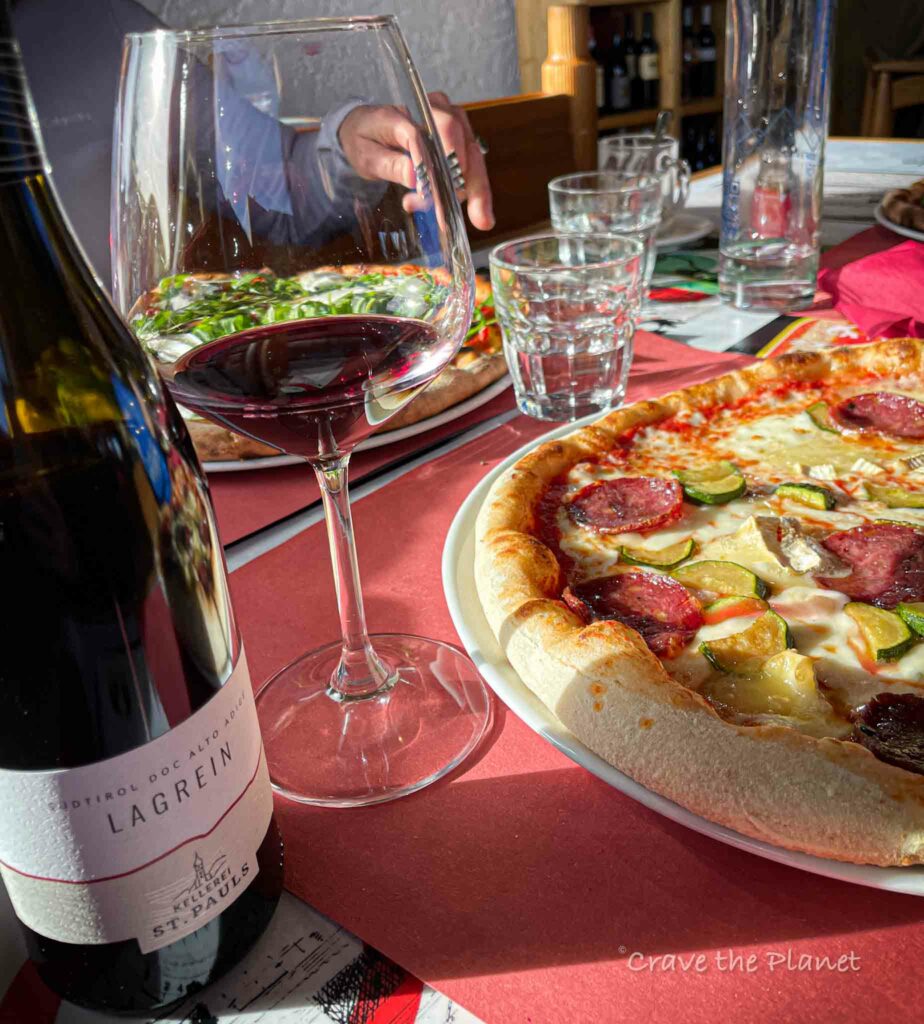
In the European mountain huts, you can expect a unique blend of simplicity and essentials that cater to your basic needs after a long day’s hike. From the food served to the sleeping quarters, these huts offer an authentic mountain experience.
Meals and Menus
When staying in these huts, you can look forward to hearty meals that are designed to fuel your outdoor adventures. Breakfast typically includes hot beverages, bread, and spreads, providing the energy you need to start your day.
Lunch can be packed for you on request or you may choose to enjoy a meal back at the hut. For dinner, a set menu is served family-style, commonly consisting of soup, a main course, and dessert.
It’s not uncommon to find a cold beer to complement your meal, allowing you to relax as you dine with fellow travelers.
Sample Menu:
- Breakfast: Tea/Coffee, Bread, Jam, Cheese
- Lunch: Sandwiches, Fruit, Snack Bar
- Dinner: Vegetable Soup, Local Stew with Potatoes, Apple Strudel
Sleeping Arrangements
Unlike typical hotels, your sleeping options are usually communal bunk beds in shared dormitories.
You will have a personal mattress and blanket, but it’s a good idea to bring your own sleeping liner for comfort.
The huts are cozy, offering a respite from the elements, and the communal arrangement fosters a sense of camaraderie among hikers.
Sleeping Quarters Overview:
- Accommodation: Communal Dormitories
- Bedding: Bunk Beds with Mattresses
- Suggested to Bring: Sleeping Liner
Amenities and Facilities

Basic amenities are available to meet your needs. You’ll have access to shared toilet facilities which are often eco-friendly due to environmental regulations in remote areas.
Showers may be available, but they could be limited to conserve water — expect them to be functional rather than luxurious.
Some larger huts might offer a spa or a traditional wood-fired stove, adding a touch of comfort to your stay.
Facilities Checklist:
- Toilets: Shared, Eco-friendly
- Showers: Available, Usage Limits May Apply
- Extras: Spa (in select huts), Stove Heating
Remember, each mountain hut can offer a different experience, so it’s wise to check for specific amenities and facilities before your trip.
Related
👉 Dolomites Hut to Hut Hiking Tips
Cultural Experience and Etiquette
Embracing the etiquette and cultural experiences of staying in mountain huts in Europe is essential for ensuring a memorable and respectful visit.
These huts, which range from basic shelters to more guesthouse-like accommodations, offer a unique way to connect with fellow hikers and nature.
Interacting with Staff and Guests
Staff: When you arrive at a mountain hut, approach the staff with a friendly greeting. Respect their guidelines, as they work hard to maintain a welcoming atmosphere for all visitors. It’s common for staff to share knowledge about the hiking area, so don’t hesitate to engage in conversation and ask for advice.
Guests: Be mindful of others’ space and experiences. Since mountain huts often involve shared sleeping quarters, observe quiet hours and keep your belongings organized. Offer a smile or a nod, as interactions are typically warm but not intrusive. Sharing stories of your trek can be a great way to bond with your fellow hikers.
Maintaining the Hut Environment
Cleanliness: Be proactive in maintaining the cleanliness of the hut. Whether it’s a simple hostel or a more equipped guesthouse, always clean up after yourself, especially in communal areas and kitchens. If you’re preparing your own food, ensure that you leave the kitchen as you found it.
Food: Some huts provide meals, but if you’re carrying your own food, remember that storage space is limited. Plan to pack out all garbage to protect the environment.
For those with specific dietary needs, such as looking for vegan options, it’s a good practice to bring necessary food items with you because huts may not always accommodate special diets.
Respectful behavior and maintaining the hut’s environment are simple yet significant ways to enhance your stay and preserve the cultural integrity of these special places. Make sure your presence adds to the collective experience of communal lodging in the beautiful mountains of Europe.
Trekking and Hiking Trails
Morgan’s Video About Hiking the Rosengarten Dolomites Hut to Hut
Europe’s vast network of trekking and hiking trails offers an array of experiences, from the well-known Tour du Mont Blanc to the rugged paths of the GR20.
Embark on hut-to-hut hikes to explore diverse landscapes and immerse yourself in the beauty of Europe’s mountain ranges.
Popular Hut-to-Hut Routes
Alta Via 1
When you set out on Europe’s trails, the Alta Via 1 in the Dolomites presents a breathtaking journey through dramatic peaks and alpine meadows, with huts strategically located to rest and refuel.
Tour du Mont Blanc
Another iconic trail, the Tour du Mont Blanc, circumnavigates the massif, offering stunning vistas and cozy huts in France, Italy, and Switzerland. If you crave a more challenging trek, the GR20 in Corsica tests your limits with its technical paths and rewarding views.
- Alta Via 1: 7-11 days, Dolomites, Italy
- Tour du Mont Blanc: 10-14 days, France/Italy/Switzerland
- GR20: 15 days, Corsica, France
For a slice of Slovenian beauty, Triglav National Park is laced with trails that lead you through its heart, replete with charming huts nestled amongst the greenery. Seeking a blend of culture and hiking?
The Haute Route connects the two mountaineering capitals, Chamonix and Zermatt, with the allure of the Matterhorn en route.
Trail Safety and Navigation
Before tackling these trails, ensure you are equipped with the right gear and possess the necessary navigation skills. Trail markers are your guide, but it’s wise to carry a map and compass or a GPS device. Check the weather forecasts and always inform someone of your itinerary before departing. Remember, safety is paramount—be prepared to adjust your plans if conditions worsen.
- Gear: suitable boots, all-weather clothing, navigation tools
- Navigation: understand trail markers, use a map, compass, or GPS
- Weather: always check forecasts, be ready to change plans
On your trek, stay on marked paths to minimize your impact on the environment and reduce the risk of getting lost. Trails like the Matterhorn’s can be treacherous; don’t hesitate to hire a local guide if you’re uncertain about the terrain.
Bold exploration awaits on Europe’s hiking trails—revel in the simplicity of hut-to-hut adventures, where each step is a new discovery and each stay is a chance to recharge amidst the beauty of nature.
Extended Trips and Advanced Planning
When embarking on extended trips through the European mountain ranges, it’s imperative to plan meticulously.
Your multi-day hike requires a defined itinerary, awareness of your budget, and decisions on whether to join a guided tour or trek independently.
Access to accurate maps and an understanding of the available amenities, such as half-board lodging in mountain huts, are crucial.
Multi-Day Hike Strategies
For multi-day hikes, crafting a precise itinerary is fundamental. Start by:
- Identifying your route based on your fitness level and interests.
- Reserving mountain huts in advance, to secure your spot, particularly during peak seasons.
- Mapping out your daily distance to ensure manageable hikes each day.
Incorporate a budget plan that accounts for:
- Accommodation costs, with options like half-board stays in mountain huts to ensure meals are covered.
- Essential gear and provisions.
- Unforeseen expenses such as local transportation or emergency supplies.
Guided Tours vs. Independent Trekking
What Kind of Hiker Are You Quiz
Are you ready to discover your hiking personality? Let’s find out what type of hiker you are with this friendly quiz! So whether your aim is capturing stunning vistas with your camera or conquering a list of mountain peaks, you’ll find your hiking persona.
Discover Your Hiker Type
Curious about "luxury backpacking in Europe"? 👉 Try my free course to settle your doubts and learn about this awe-inspiring experience.
When considering guided tours, evaluate:
- The added value of a guide's expertise on local culture, flora, and fauna.
- The benefit of prearranged logistics, which can include transportation and reservations.
In contrast, independent trekking allows for:
- A flexible schedule, letting you modify your path as you see fit.
- Opportunities to challenge yourself in navigation and self-sufficiency, often relying on detailed maps and trail guides.
By anticipating the challenges and rewards of both options, you'll be better prepared to choose the experience that aligns with your skills and expectations.
Related
👉 TMB Guided VS Self Guided
Membership and Affiliations

When exploring the vast and scenic mountain ranges of Europe, memberships in alpine clubs can be your gateway to an enhanced experience. These affiliations not only connect you to a community of like-minded enthusiasts but also unlock a range of benefits tailored for the alpine adventurer.
Benefits of Joining Alpine Clubs
By joining an Alpine Club, you position yourself within a network of passionate mountaineers and nature lovers. Membership often includes safety training, route information, and rescue services, essential for any expedition into the rugged landscapes. Clubs like the Austrian Alpine Club offer a sense of camaraderie, knowledge exchange, and the opportunity to participate in conservation efforts to protect the mountain environments you love.
Discounts and Exclusive Access
Alpine Club memberships frequently come with financial perks. Expect to enjoy discounted stays at rifugios (mountain huts) across various ranges, which can significantly lower your trip costs. Additionally, gain exclusive access to member-only huts and advance booking privileges. For example, members of the Austrian Alpine Club benefit from reduced rates at over 500 huts in the Alps and further discounts on alpine courses and events.
Safety and Emergency Information
Ensuring your safety in European mountain huts requires an understanding of the challenges posed by altitude and weather, as well as knowledge of emergency services and evacuation procedures. Being prepared will help manage any risks associated with your adventure.
Dealing with Altitude and Weather Extremes
Altitude Sickness: When staying at high altitudes, you may be at risk of altitude sickness. Symptoms include headache, nausea, and dizziness. It's crucial to acclimatize gradually and stay hydrated. Carry first aid equipment and know the signs to look out for.
- Prevention Steps:
- Ascend slowly to allow your body to adjust.
- Drink plenty of water to prevent dehydration.
- Avoid alcohol and sleeping pills.
Weather Conditions: Mountainous areas are prone to sudden weather changes. It's imperative to check forecasts prior to trekking and to understand that weather conditions can greatly affect your safety. Be equipped for extremes, such as storms or heavy snow.
- Preparedness Checklist:
- Waterproof clothing and layers for insulation.
- Always carry a map, compass, and GPS device.
- Stay informed on the latest weather updates.
Emergency Services and Evacuation
Helicopter Rescue: In critical situations where immediate descent is not possible, helicopter rescue may be necessary. Insurance that covers search and rescue operations can provide peace of mind and financial protection.
- When to Call for Help:
- Severe injury where you are unable to descend.
- Suspected altitude sickness with worsening symptoms.
- Sudden severe weather where evacuation is required.
Emergency Contacts: Always have access to local emergency contacts and understand the protocols for mountain huts in case of an emergency.
- Key Actions:
- Make note of the nearest mountain hut's emergency contact information.
- Understand the signal procedures for alerting rescue services.
- Ensure your travel companions are aware of these details.
Prioritize your safety by staying informed, prepared, and vigilant to enjoy a memorable and secure experience in Europe’s mountain regions.
In case of emergency 👉 Rescue Insurance
Crave the Planet partners with Global Rescue to offer the world’s leading travel protection services. Medical and security emergencies happen. When they do, we rely on Global Rescue to provide our clients with medical, security, travel risk and crisis response services.
Without a membership, an emergency evacuation could cost over $100,000. More than one million members trust Global Rescue to get them home safely when the unexpected happens. Learn more about trekking insurance, but we highly recommend our audience enroll with Global Rescue.
Pros and Cons
- Comprehensive Emergency Services: Members have access to a wide array of emergency services, including medical and security evacuations, field rescues, and telemedicine consultations.
- Global Coverage: Global Rescue operates around the world, offering support and evacuation services in both remote and urban settings, which is particularly beneficial for travelers and adventurers.
- Expertise and Resources: The company is well-regarded for its team of medical and security experts and has a partnership with Johns Hopkins Medicine, ensuring high-quality advice and care.
- Cost Factor: The membership can be expensive, especially for those who travel infrequently or are on a limited budget.
- Membership vs. Per-Trip Insurance: Since the services are membership-based, they may not be as cost-effective for those seeking coverage for a single trip as opposed to regular travelers.
- Limited Traditional Travel Insurance Benefits: The membership focuses on emergency evacuation and rescue, which means it may lack comprehensive trip insurance features like trip cancellation, baggage loss, or delay coverage.
Sustainability and Environmental Responsibility
When you retreat to Europe's mountains for adventure or solace, carrying an ethos of environmental responsibility ensures the longevity and health of these cherished natural spaces. Your conscious actions as a trekker contribute to the ongoing efforts in wildlife conservation and maintaining the delicate ecology of alpine regions.
Responsible Trekking
Your Footprint Matters: Always practice Leave No Trace principles. This includes sticking to established trails, which minimizes soil erosion and protects undergrowth. Carry out what you carry in, managing your waste to prevent pollution and disruption to the local wildlife.
Planning and Preparedness: Decide on routes that mitigate environmental impact, and use existing campsites to avoid damaging pristine areas. Be informed about the local regulations and seasonal concerns that may affect the area's sustainability.
Protecting the Alpine Ecosystem
Conservation Efforts: Engage with local conservation initiatives actively protecting the alpine ecosystem. This could involve monetary support or participating in volunteer programs aimed at ecological preservation.
Wildlife Protection: Be mindful of the wildlife in Europe's mountainous areas. Observing animals from a distance prevents stress and interruption to their natural behaviors. Additionally, educating yourself about indigenous species helps in recognizing and avoiding sensitive habitats.
By being vigilant and respectful, your journey through Europe's mountain huts can align with a greater purpose of conserving these magnificent landscapes for the future.
Seasonal Considerations
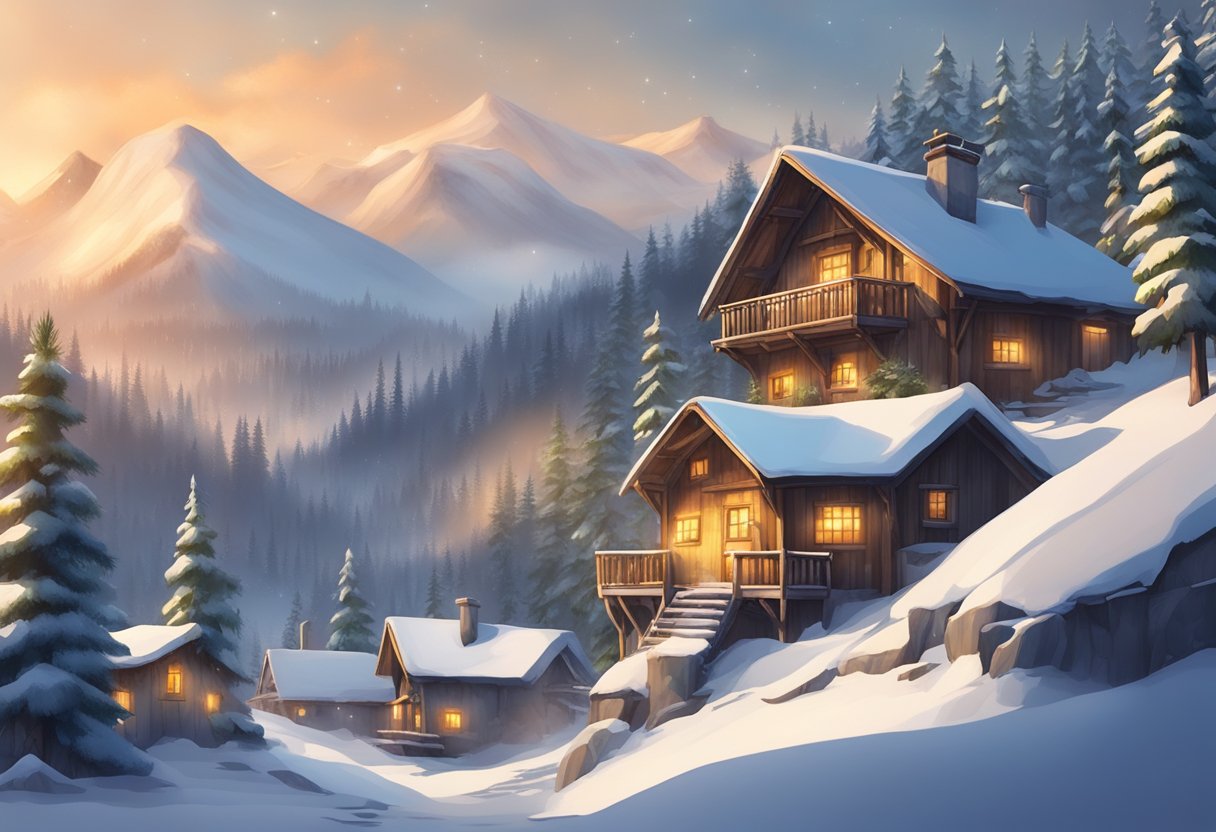
When planning your mountain hut experience in Europe, the season significantly influences your activities and preparation. The Alps offer distinct experiences whether you're visiting in the warm summer months or the snow-capped winter season.
Summer Hiking Opportunities
During summer, you have the opportunity to explore vast networks of trails with breathtaking views. The Alps are dotted with mountain huts that serve as the perfect base for your hiking adventures.
For instance, in areas like Chamonix or Zermatt, you can enjoy long days with a milder climate, making the challenging hikes more manageable. You can stay full time in these huts, as many operate throughout the summer season, providing you a chance to hike from hut to hut without returning to the valley floors.
- Stay at mountain huts to extend your range
- Milder climate for comfortable hiking conditions
- Long days for extended exploration
Winter Ski Touring and Ski Safari Dolomites
Winter in the Alps transforms the landscape into a snowy paradise, ideal for ski touring and experiencing the serene beauty of the mountains. However, winter conditions require thorough preparation for the cold and avalanche risk.
Some mountain huts are specially equipped for the winter season; they not only provide shelter but also serve as key points for skiing enthusiasts exploring the snowy slopes of regions like Zermatt.
- Prepare for cold weather and avalanche risk
- Seek huts equipped for winter needs
- Embrace the unique serenity of winter
Remember that access to huts during the winter may vary, and it is essential to check the operation schedules and availability in advance, as some may close outside of the ski season.
Final Thoughts
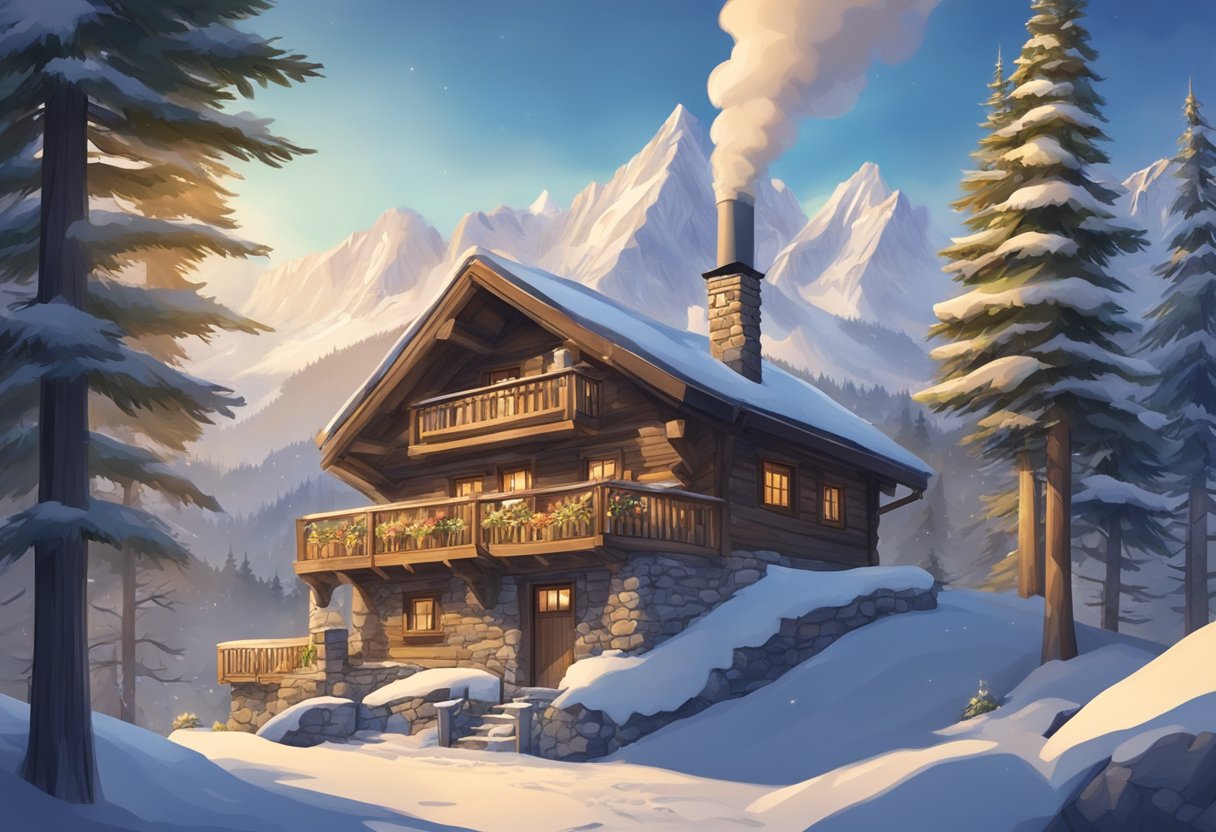
When planning your stay in mountain huts across Europe, confidence in your journey stems from reliable planning. Booking your hut in advance provides security, ensuring a place to rest during your trek.
Your Experience
Expect a blend of simplicity and authenticity. These huts offer a chance to disconnect from the hustle of everyday life, creating memorable experiences that resonate long after your return.
What You'll Find
- Beds, ranging from communal bunks to private rooms
- Shared facilities, typically with basic amenities
- Common dining areas, fostering a sense of community
Stay informed about the specific hut offerings on your route, as amenities and capacities vary. The tranquility of the mountains coupled with the unique camaraderie found at these huts can make your adventure more than just a hike; it's a chance to forge connections with fellow hikers and with nature itself.
Safety and Preparedness
- Be cognizant of weather conditions
- Carry essential gear for sudden changes in the climate
- Respect hut rules and preserve the serene environment for future visitors
By respecting these sanctuaries in the sky, you contribute to their upkeep and reliability for many more adventurers to come. With careful planning and a respectful approach, your trek through Europe's elevated landscapes can be a truly enriching encounter.
Ready to Book a Hut to Hut Hike?
Final Verdict: Ways to Book a Hut to Hut Hiking Trip
Self-Guided Tour Planning Service
- [Self-Guided] - You're on your own once you start
- Must book in Oct to Jan of year prior to hike
- Fully done for you route
- Service finds and books your huts
- Maps provided on app
- small groups (<10 typically)
- local Chamonix guides
- all transfers/breakfast/dinner/accommodations included
- airport transfer included
- stay in the insanely beautiful Rifugio Bonatti and other huts at high elevation
- Cheapest Option
- Most Freedom
- Take side excursions as you like
Camping
- campgrounds can be crowded
- reservations often needed in advance
- Wild camping is prohibited or limited by elevation
Frequently Asked Questions
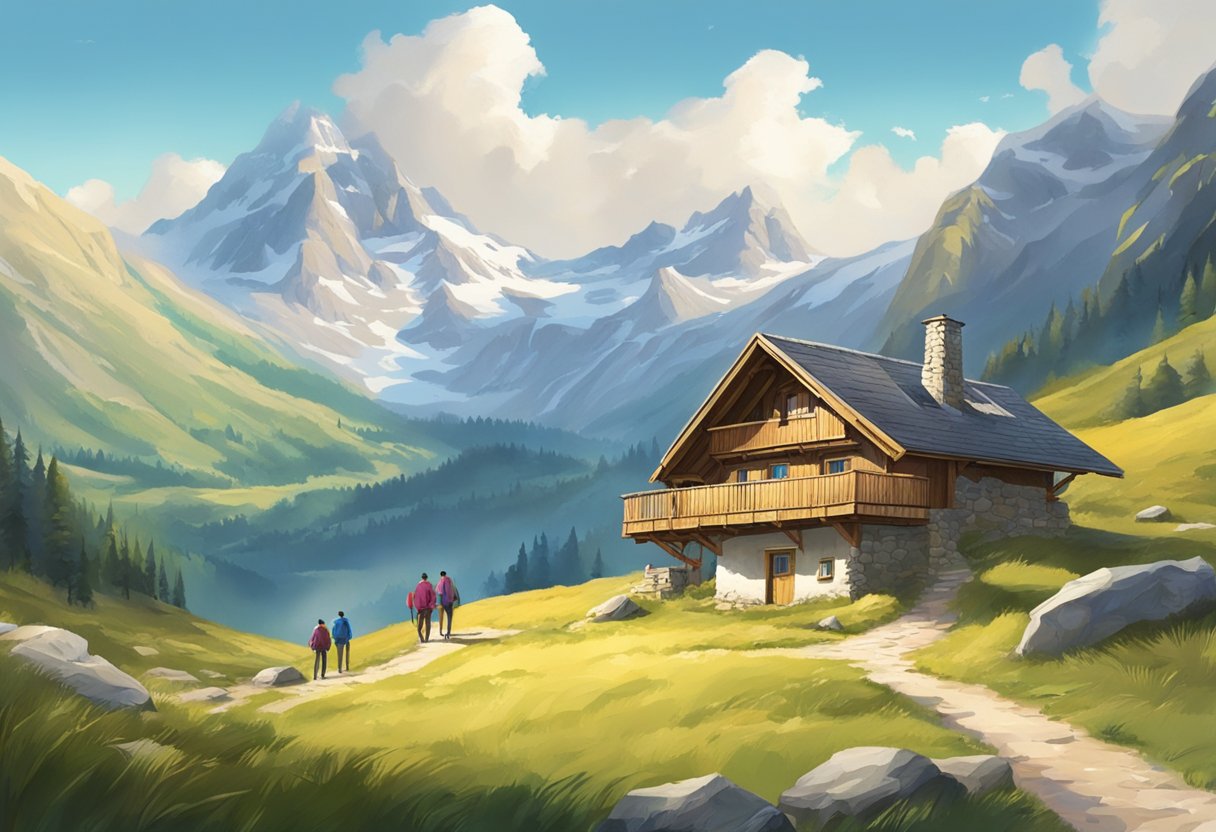
In this section, you'll find concise responses to common inquiries about alpine hut experiences, including preparation tips, costs, reservations, etiquette, and the option of renting a private hut.
What are the best hut-to-hut hikes available in the European Alps?
The Tour du Mont Blanc and the Haute Route are considered premium hut-to-hut hikes. They offer spectacular views and a series of comfortable huts for overnight stays.
How can beginners prepare for staying in mountain huts in Europe?
Beginners should focus on physical preparation, acquiring proper gear, and understanding hut amenities. It's important to book in advance and be aware of the altitude effects and weather conditions.
What are the typical costs for staying in mountain huts in the Dolomites?
Costs for staying in mountain huts in the Dolomites may range from 60 to 125 euros per night for a dormitory-style bed, including a half-board option with breakfast and dinner.
How does one go about reserving a mountain hut in the Alps?
Reserve a mountain hut by contacting the hut directly or booking online through regional alpine clubs or tourist offices. Plan and book well in advance due to high demand.
What is considered proper etiquette when staying in European mountain huts?
Proper etiquette includes respecting quiet hours, cleaning up after yourself, and being considerate of shared spaces. You should also greet fellow guests and follow the hut rules.
Can you rent a private mountain hut in Switzerland, and if so, how?
Yes, you can rent a private mountain hut in Switzerland by researching online for private hut rentals and directly contacting the owners or managing agencies for availability and booking.
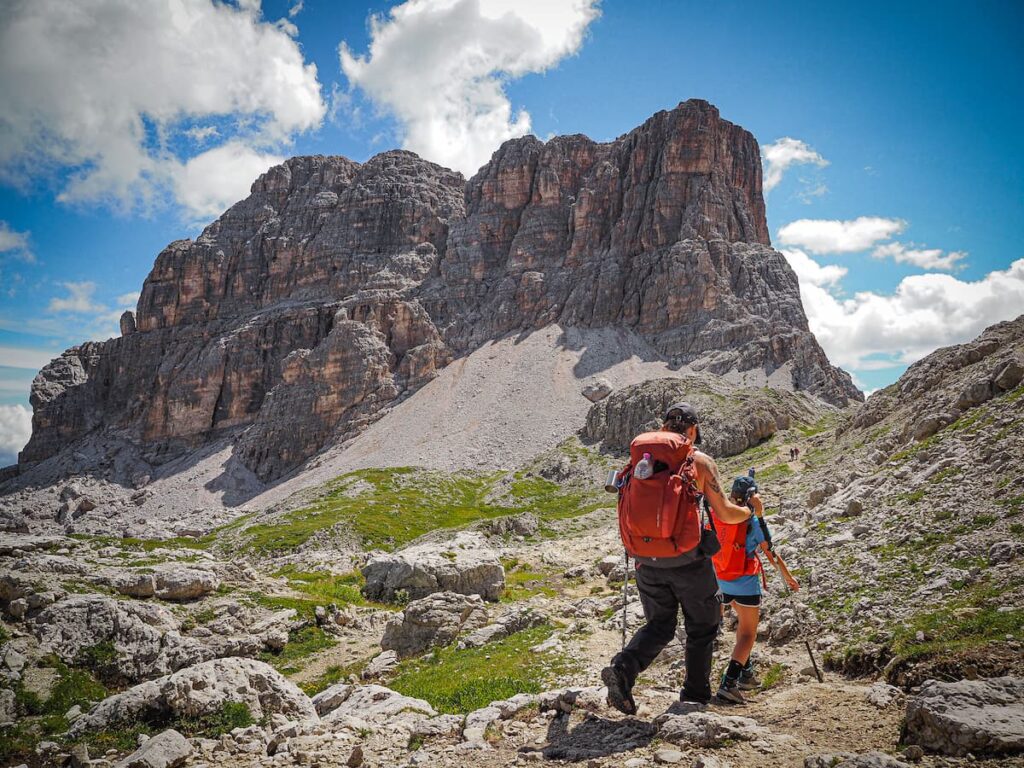
Hut to Hut Hiking in the Dolomites Free Course
Curious about hut-to-hut hiking in the Dolomites, but not sure where to start or what to expect? Sign up for our newsletter that simplifies and educates so you can focus on the views and vino. Get curious, get ready, and let's get started! Sign up here👇🏼
- Free Email Course to Learn : Everything You Need to Know About Hut to Hut Hiking

Author profile: Morgan Fielder is a Doctor of Physical Therapy and passionate hiker who believes in exploring the world on foot with good food. Follow her journey as she shares science-based hiking tips and advocates for sustainable tourism.

